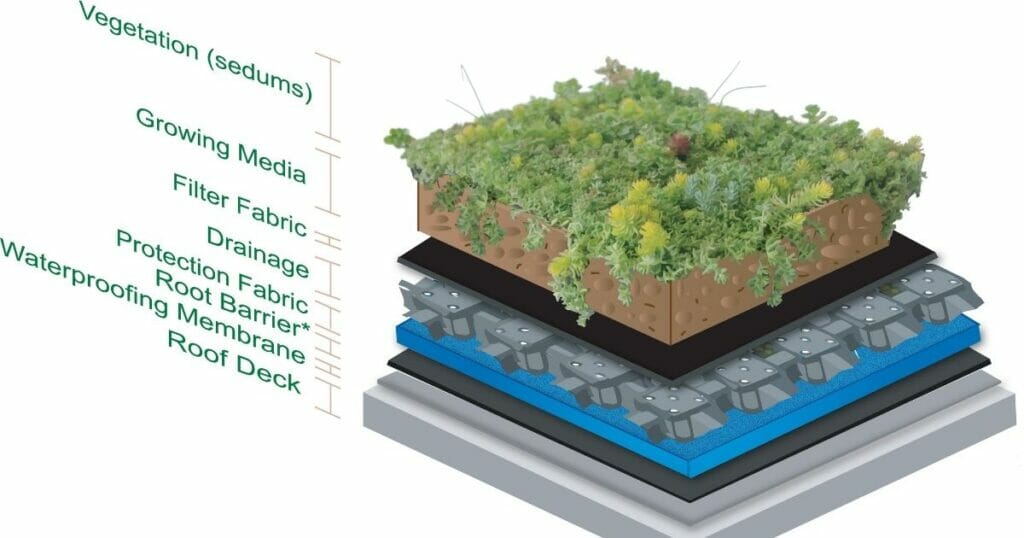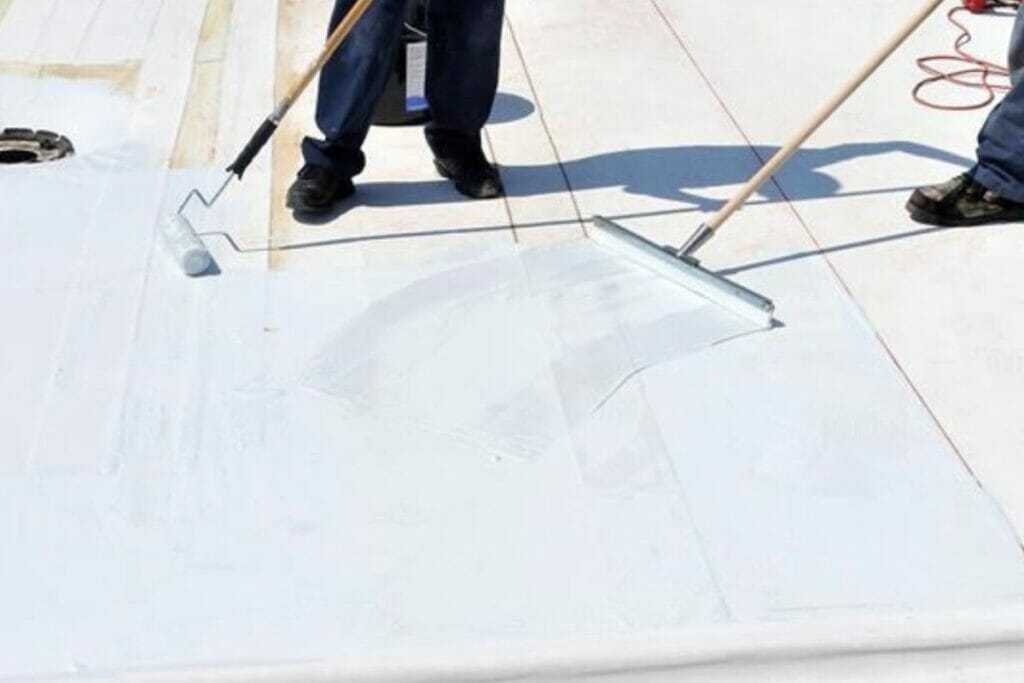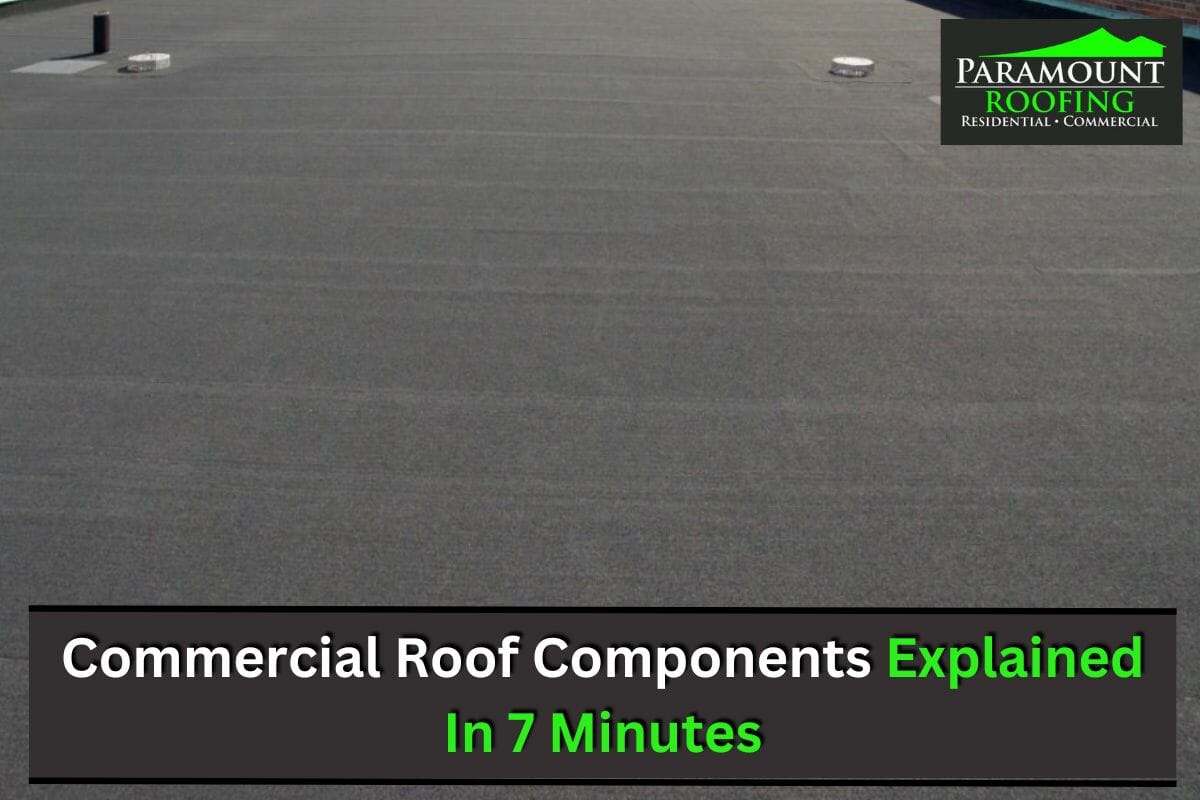It might surprise you to know that the global commercial roofing market is projected to reach a staggering $17.08 billion by 2029, further emphasizing its significance in the construction industry. This growth is strongly attributed to advancements in roofing techniques and materials which have revolutionized the way we protect our buildings from harsh weather conditions.
However, understanding these complex systems can seem daunting if you’re unfamiliar with their components.
In this guide, we’ll explain the parts of a flat commercial roof. At Paramount Roofing, we aim to make it simple for both building owners and construction professionals to grasp these vital concepts quickly yet thoroughly.
So whether you’re planning your next construction project or are just curious about what keeps your office dry during a storm, stick around as we delve into the world of commercial roof components!

#1 Roof Deck
It’s the roof deck that forms the backbone of any rooftop. It becomes a critical component in roof deck installation and maintenance as it provides a solid base for roofing materials while also playing an integral part in weather protection.
The benefits of a well-constructed roof deck are numerous, ranging from structural support to promoting adequate drainage and facilitating insulation. Roof decks can be made from different types of materials, such as plywood, concrete, or steel, with each offering varying degrees of durability, cost-effectiveness, and ease of installation.
When we look at roof deck construction closely, proper waterproofing is paramount to prevent potential problems like leaks or damage from extreme weather conditions. This ensures that the lifespan of your roof deck is extended significantly. However, despite regular maintenance and necessary precautions taken during installation, no roof deck is immune to wear and tear over time. Hence, understanding common roof deck problems like pooling water or material degradation can help you plan for timely repairs or replacements.
As far as costs are concerned, they can vary widely depending on your choice of materials and the complexity of the installation process, but investing in a robustly constructed roof deck will undeniably pay off in terms of longevity and reduced repair costs down the line.
#2 Vapor Barrier
A vapor barrier is among the critical components of a flat roof that help control the movement of moisture and water vapor. It is typically a thin, waterproof membrane or layer installed between the roof deck and the insulation or roofing materials. The main purpose of a vapor barrier is to prevent moisture from seeping into the roofing system from the interior of the building or from the outside environment.
In colder climates, where the interior of the building is heated, warm, moist air can rise and penetrate the roofing system. When this warm air reaches a cold surface within the roof structure, such as the roof deck or insulation, it can condense into water droplets. Over time, this condensation can lead to issues like mold growth, rotting of wood, and reduced insulation effectiveness.
By installing a vapor barrier, the movement of moisture is restricted, minimizing the risk of condensation and potential damage. Vapor barriers are particularly important in climates where temperature variations and humidity levels are significant.
#3 Insulation
Just as a warm coat shields you from winter’s chill, proper insulation in your building’s roof acts as a barrier against extreme temperatures, keeping the inside comfortable regardless of harsh weather conditions outside.
The benefits of installing quality insulation are multifaceted. It significantly enhances energy efficiency by reducing heat loss in the winter and heat gain during the summer. This means less strain on your heating or cooling systems and substantial savings on energy bills. Insulation also plays a crucial role in soundproofing, minimizing noise transmission between the exterior and interior of the building.
In terms of environmental impact, effective insulation can reduce your carbon footprint by lowering energy consumption. There are various types of insulation used in commercial roofing, including fiberglass, cellulose, spray foam, and rigid board. Each has its own unique properties regarding fire resistance, cost considerations, and the installation process.
Regardless of the type chosen, it’s essential to consider local climate conditions along with specific needs and budget constraints when making your selection, as these factors significantly influence the overall performance and longevity of the roof insulation system.
#4 Flashing
Flashing is a critical component of flat roofs that is often overlooked, but is essential to preventing water damage.
Flashing is typically made up of metal and serves as an additional barrier against moisture, particularly around roof edges and equipment like vents, pipes, and HVAC systems. Various types of flashing materials are available, including copper, aluminum, stainless steel, zinc, and rubber. The choice depends on your specific roof type and climate considerations.
Proper installation of flashing is crucial to maintain its effectiveness. Incorrectly installed flashing can lead to leaks and structural problems over time. Remember that different types of flashing applications require unique installation techniques. A sturdy roof flashing system contributes significantly towards energy efficiency by preventing air leaks, thus reducing unnecessary heating or cooling costs for your building.
However, it’s also important to be aware of local regulations and codes concerning commercial roof installation. These may dictate certain requirements regarding the use and installation of flashing depending on your location’s climate risks.
#5 Roof Covering Material
This is the topmost part of a commercial roof. Choosing the right roof covering material is crucial since it must be energy-efficient, durable, and fit just right! The variety of options at our disposal can be mind-boggling, ranging from an EPDM rubber roof to a sustainable green roof.
Each type of roofing material has its own benefits and drawbacks in terms of cost, longevity, maintenance requirements, and impact on energy efficiency. For instance, while single-membrane TPO roofs are popular due to their lower price and energy-efficient nature, these membranes may not last as long as metal roofs and built-up roofs.
When choosing a commercial roof covering material, it’s important to consider both initial costs as well as long-term maintenance costs. Some more sustainable roofing materials might cost more upfront but could save you money in the long run due to their durability and energy-efficiency properties.
Below is a handy table summarizing some popular choices:
| Roofing Material | Cost | Longevity | Maintenance | Energy Efficiency |
|---|---|---|---|---|
| EPDM | Low | High | Moderate | Moderate |
| Metal Roofing | High | High | Low | High |
| TPO Roofing | Moderate | Low | Moderate | High |
| PVC | Low | Moderate | Moderate | Moderate |
| Green Roofing | Very high | Very high | High | Very high |
#6 Drains and Scuppers
Drains and scuppers are essential components of a commercial roofing system designed to ensure proper drainage of rainwater from the roof’s surface. Efficient drainage is crucial to prevent water from pooling or ponding on the roof, which can lead to structural damage and leaks.
Drains
Roof drains are openings or outlets installed at low points on the roof to allow water to flow off the roof and into the building’s drainage system. They are typically connected to downspouts or pipes that direct the water away from the building’s foundation.
Scuppers
Scuppers are similar to drains but are open-sided outlets or channels that allow water to flow off the edge of a roof parapet or wall. They are commonly found on flat or low-slope roofs and are particularly useful in areas where traditional roof drains may not be feasible or sufficient.
Properly designed and installed drains and scuppers help prevent water from accumulating on the roof, which can lead to water damage, structural issues, and increased stress on the roofing system.
#7 Roof Coatings

One additional commercial roof component is a roof coating. It serves multiple functions, including waterproofing the roof, providing UV protection, preserving the roofing material, sealing seams and cracks, and reducing maintenance needs. By extending the lifespan of the roofing membrane and improving energy efficiency, a suitable roof coating helps maintain a durable and weather-resistant commercial roofing system.
Roof coatings are typically made of various materials, including acrylic, silicone, polyurethane, asphalt-based compounds, or a combination of these. They are applied as liquid coatings that cure to form a seamless, protective membrane over the existing roofing material. Regular maintenance and reapplication may be required overtime to maintain the coating’s effectiveness and prolong the life of the commercial roofing system.
#8 The Green Roofing Trend
It’s undeniable that the trend toward green roofing is making waves in the construction industry worldwide. Not only does this innovative approach contribute to sustainability, but it also brings a plethora of other benefits.
Green roofing can significantly reduce stormwater runoff, improve air quality, and provide excellent insulation, all while introducing an aesthetic element to urban areas often devoid of green spaces. There are several types of green roofs, including ones with rooftop parks, small gardens, and cool roof terraces with plants.
The initial cost of a green roof is higher than conventional roofs. Further investment in its maintenance is also necessary to ensure plant life thrives and potential issues such as water leakage are prevented early on. However, many case studies show that over time these costs can be offset by energy savings and increased property value.
The regulations around green roofs vary globally. Some cities offer incentives for green roof installations, while others have made them mandatory in certain zones or building types. With proper planning and understanding of local regulations, businesses can fully harness the benefits of green roofs while contributing positively to their city’s environmental efforts.
If you are looking for a flat roof installation service in Metro Detroit, our commercial roofing experts are ready to help you!
Free Consultation and Estimate on Commercial Roofing Projects in Metro Detroit
At Paramount Roofing, we understand the challenges property owners face in protecting their valuable investments from the harsh elements of nature. That’s why we take immense pride in being counted among the top commercial roofing contractors in Detroit and the surrounding areas in Michigan. We go beyond fixing roofs: we’re here to provide peace of mind and security. We’re not just in the business of roofing, we’re in the business of making sure your property remains safeguarded and economical for years to come.
Call us at (586) 690-0227 for a free consultation and estimate on your commercial roof replacement in Metro Detroit.
 Free Estimate
Free Estimate
 Request Service
Request Service Locations
Locations 
